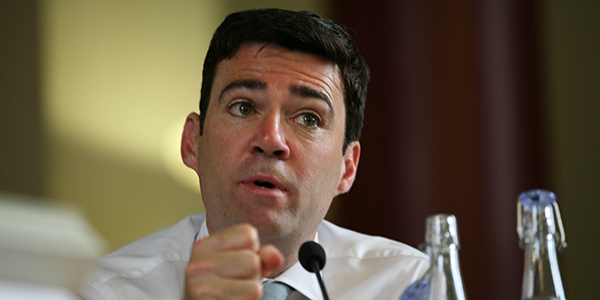Assessing England’s metro-mayors: a mixed picture
Directly elected mayors for Combined Authorities have been introduced in a piecemeal fashion across England since 2017. Jane Roberts analyses how they have operated, and finds that there is considerable variation in their effectiveness, depending on local circumstances and individual leadership, but to understand these differences, better evaluation of their performance is needed.

Greater Manchester Mayor, Andy Burnham. Picture: The BMA / (CC BY-NC 2.0) licence
It has been three years since the first six metro-mayors were elected in 2017 to lead the newly established Combined Authorities in England. Four of these six (in Greater Manchester, Liverpool City Region, Tees Valley and West Midlands) were to have been up for election again in May – until Covid-19 intervened. Now these, along with mayoral elections in Cambridgeshire and the West of England, will take place in May 2021. CA mayors elected after 2017 will be up for election in 2022 and later, including a new mayoral authority announced for West Yorkshire in the 2020 Budget.
Since their establishment, what have we learnt about Mayoral Combined Authorities (CAs)? The 22% of the population who elected a metro-mayor in 2017 have shown little interest so far in terms of electoral turnout, ranging from 21% to 34%. But CAs are a key part of vexed issue of the governance of England which has acquired more significance partly in the light of the referendum result of 2016 in which the UK (narrowly) voted to leave the European Union under the resonant banner of ‘take back control’.
A Combined Authority can be formed by two or more local authorities that come together to agree a bespoke deal with central government permitting some powers to be devolved to the CA. Here I offer some thoughts on the first mayoral CAs drawing on research I conducted on the leadership of the six Mayoral Combined Authorities during the very early days of their metro-mayors’ tenure.
First, let us be clear about the serendipitous means by which CAs emerged. Despite some re-telling of history, CAs were not at their inception part of any grand strategic design for democratic renewal or to boost local economic growth. They were simply, as one official from the Ministry of Housing, Communities and Local Government said, ‘the answer to the question that Manchester put’. In the early 2000s, the ten local authorities in Greater Manchester had sought to formalise their decades’ long collaboration as the Association of Greater Manchester Authorities (AGMA). At the tail end of the last Labour government, they were enabled to do so by an addition to the Local Democracy, Economic Development and Construction Act of 2009. Greater Manchester Combined Authority (then with no mayor) was established in 2011.
Having abolished Regional Development Agencies and brought in unelected Local Economic Partnerships, the coalition government of 2010 to 2015 only later came to realise the usefulness of an arrangement such as a CA. CAs came to be seen as a means by which to ensure ‘appropriate accountability structures’ were in place for funding that was to be devolved as bespoke City Deals, promoted in Heseltine’s influential review of 2012, and later known as ‘devo deals’. Mayoral CAs were vigorously championed by George Osborne, then Chancellor of the Exchequer (and MP for Tatton), in part in order to make electoral inroads by the Conservative Party into what had been traditional Labour heartlands, a strategy that has since been remarkably successful.
With the original Manchester model having been ‘reshuffled’, mayoral CAs have emerged, mostly in urban city regions. They have been seen as a usefully disruptive force in a sector held in ‘elite contempt’ by Whitehall. Perhaps too disruptive at times: Greater Manchester Mayor Andy Burnham’s vociferous criticism of train services in the north has irked Whitehall. Crucially, contractual delivery of devolution deals can be easily monitored, a potentially centralising device. And CAs have been favoured over local authorities for additional funding, for example from the Transforming Cities Fund.
Unlike the London Mayor and the GLA, the constitutions of CAs significantly constrain metro-mayors, despite the rhetoric of swash-buckling figures, harbingers of great change. Mayoral CAs have a cabinet made up of the leaders of the constituent local authorities who may or may not be of the same political persuasion. Directly elected they may be but metro-mayors are still bound to work closely with, ‘the cabinet you can’t appoint, you can’t tell what to do and you can’t get rid of’, as one council leader pithily out it. Relationships, persuasion and collaboration are what it’s all about – although not all metro-mayors appear to take this on board. It is hardly surprising then that most of the metro-mayors have sought to make the most of their relatively limited ‘hard’ powers – with relatively small amounts of money available for infrastructure – and to maximise their ‘soft powers’. The power of a mayoral press release was ruefully acknowledged to have been underestimated by some local authority constituent members. And let us not forget that all the metro-mayors elected so far are white men – plus ça change – not least as direct elections tend to disadvantage candidates from other groups.
The differences between mayoral CAs are greater than some might think. Each has a bespoke deal with different powers devolved but perhaps more important are the local contexts, historical and present, into which metro-mayors were elected and the agency of individual mayors, echoing Lowndes and Lempriere’s focus on ‘leaders, legacies and localities.’
The background to the establishment of each CAs varies greatly in terms of the degree to which any one CA is deemed to be a recognised ‘place’ and how much contention there has been over boundaries; the history of effective collaboration (or not) between authorities in the area; and the intensity of local rivalries including possibly the greatly ruffled feathers of disappointed defeated mayoral candidates. Individual mayors vary enormously in visibility, dynamism and style. Two – Andy Burnham and Andy Street, Mayor of the West Midlands – are nationally known figures, while one would barely be recognised locally. A couple have forged effective, trusting relationships with colleagues while relationships elsewhere have ranged from tense to frankly terrible.
So, are mayoral CAs a promising addition to English governance? Are they a more effective delivery mechanism for new infrastructure? Do metro-mayors engage and inspire the public? Greater Manchester’s may score well on all these counts given its long history of collaboration, its popular, politically astute mayor and highly engaged local authorities. As for the others, the jury is out. Their mayors were elected in less fertile terrain than Manchester’s. And the directly elected mayors themselves have been something of a gamble, in terms of who gets selected and elected.
As the government have no intention of evaluating CAs, despite such a recommendation from the National Audit Office in 2017, we shall never really know the answer to the questions above. Yet there needs it be more clarity of the purpose of mayoral CAs and thoughtful consideration about how they fit (or not) into the wider governance of England.
This gives the views of the author, not the position of Democratic Audit. It draws on the author’s article, ‘The leadership of place and people in the new English combined authorities‘, published in Local Government Studies.
About the author

Dame Jane Roberts is Research Fellow in Public Leadership at The Open University Business School. Jane is a medical doctor and worked for many years as a hospital consultant in Child and Adolescent Psychiatry. She was Leader of the London Borough of Camden from 2000 to 2005. She chaired the Councillors Commission for the Department of Communities and Local Government (2007-2009) and amongst other roles, she is Chair of the charity Living Streets.





 Democratic Audit's core funding is provided by the Joseph Rowntree Charitable Trust. Additional funding is provided by the London School of Economics.
Democratic Audit's core funding is provided by the Joseph Rowntree Charitable Trust. Additional funding is provided by the London School of Economics.